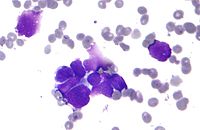
Photo from wikipedia
Background Pancreatic medullary carcinoma (PMC) is a rare pancreatic tumor, usually showing the presence of microsatellite instability, mostly MLH1 silencing, and a wild-type KRAS mutation status. We report here a… Click to show full abstract
Background Pancreatic medullary carcinoma (PMC) is a rare pancreatic tumor, usually showing the presence of microsatellite instability, mostly MLH1 silencing, and a wild-type KRAS mutation status. We report here a PMC arising from a Pancreatic Intraductal Papillary Mucinous Neoplasm (IPMN), both having KRAS and TP53 mutations. Case presentation We report the case of a 73-year-old woman presenting with right iliac fossa pain. MRI revealed a 16 mm diameter mass in the pancreas, leading to a pancreatic duct stricture and upstream a dilatation of the distal pancreatic duct of Wirsung. A fine needle aspiration was performed, and pathology analysis revealed malignant glandular cells. The patient underwent distal pancreatectomy. Gross examination revealed an12 mm indurated white lesion, adjacent to a cystic lesion extending into the rest of the pancreatic body. Microscopically, the cystic area represented a mixed (gastric-type and pancreatobiliary-type) IPMN, involving the main and secondary pancreatic ducts with low-grade and high-grade dysplasia. In the periphery of this IPMN, a 14mm associated invasive carcinoma was observed, characterized by focal gland formation and by poorly differentiated cells with a syncytial appearance, associated with a dense lymphoplasmocytic and neutrophilic infiltrate. Immunohistochemical analyses showed loss of MSH2 and MSH6 expression. Microsatellite instability was confirmed by molecular test. Molecular analysis was performed both on the invasive carcinoma and on the high-grade dysplasia IPMN, revealing the same mutation profile with KRAS and TP53 mutations. The proposed diagnosis was mixed IPMN with associated invasive medullary carcinoma that presented loss of MSH2 and MSH6 expression. Conclusions The present case reports for the first time, at the best of our knowledge, the coexistence of IPMN lesions and PMC, both having the same molecular alterations. It also describes the second case of PMC with microsatellite instability, MSH2 and MSH6 silenced.
Journal Title: Diagnostic Pathology
Year Published: 2021
Link to full text (if available)
Share on Social Media: Sign Up to like & get
recommendations!